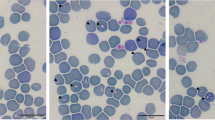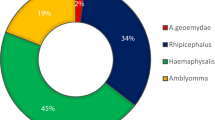Abstract
The present work aimed to investigate the genetic diversity of Bartonella in mammals and ectoparasites in Pantanal wetland, Brazil. For this purpose, 31 Nasua nasua, 78 Cerdocyon thous, 7 Leopardus pardalis, 110 wild rodents, 30 marsupials, and 42 dogs were sampled. DNA samples were submitted to a quantitative real-time PCR assay (qPCR). Positive samples in qPCR were submitted to conventional PCR assays targeting other five protein-coding genes. Thirty-five wild rodents and three Polygenis (P.) bohlsi bohlsi flea pools showed positive results in qPCR for Bartonella spp. Thirty-seven out of 38 positive samples in qPCR were also positive in cPCR assays based on ftsZ gene, nine in nuoG-cPCR, and six in gltA-cPCR. Concatenated phylogenetic analyses showed that two main genotypes circulate in rodents and ectoparasites in the studied region. While one of them was closely related to Bartonella spp. previously detected in Cricetidae rodents from North America and Brazil, the other one was related to Bartonella alsatica, Bartonella pachyuromydis, Bartonella birtlesii, Bartonella acomydis, Bartonella silvatica, and Bartonella callosciuri. These results showed that at least two Bartonella genotypes circulate among wild rodents. Additionally, the present study suggests that Polygenis (P.) bohlsi bohlsi fleas could act as possible Bartonella vectors among rodents in Pantanal wetland, Brazil.




Similar content being viewed by others
References
Birtles RJ, Raoult D (1996) Comparison of partial citrate synthase gene (gltA) sequences for phylogenetic analysis of Bartonella species. Int. J. Syst. Bacteriol. 46:891–897
Breitschwerdt EB (2014) Bartonellosis: one health perspectives for an emerging infectious diseases. ILAR J. 55:46–58. https://doi.org/10.1093/ilar/ilu015
Gutiérrez R, Krasnov B, Morick D, Gottlieb Y, Khokhlova IS, Harrus S (2015) Bartonella infection in rodents and their flea Ectoparasites: an overview. Vector Borne Zoonotic Dis. 15:27–39. https://doi.org/10.1089/vbz.2014.1606
Costa F, Porter FH, Rodrigues G, Farias H, de Faria MT, Wunder EA, Osikowicz LM, Kosoy MY, Reis MG, Ko AI, Childs JE (2014) Infections by Leptospira interrogans, Seoul virus, and Bartonella spp. among Norway rats (Rattus norvegicus) from the urban slum environment in Brazil. Vector Borne Zoonotic Dis. 14:33–40. https://doi.org/10.1089/vbz.2013.1378
Favacho AR, Andrade MN, de Oliveira RC, Bonvicino CR, D'Andrea PS, de Lemos ER (2015) Zoonotic Bartonella species in wild rodents in the state of Mato Grosso do Sul, Brazil. Microbes Infect. 17:889–892. https://doi.org/10.1016/j.micinf.2015.08.014
Fontalvo MC, Favacho ARM, Araujo AC, Santos NMD, Oliveira GMB, Aguiar DM, Lemos ERS, Horta MC (2017) Bartonella species pathogenic for humans infect pets, free-ranging wild mammals and their ectoparasites in the Caatinga biome, Northeastern Brazil: a serological and molecular study. Braz. J. Infect. Dis. 21:290–296. https://doi.org/10.1016/j.bjid.2017.02.002
Gonçalves LR, Favacho AR, Roque AL, Mendes NS, Fidelis Junior OL, Benevenute JL, Herrera HM, D'Andrea PS, de Lemos ER, Machado RZ, André MR (2016) Association of Bartonella species with wild and synanthropic rodents in different Brazilian biomes. Appl. Environ. Microbiol. 82:7154–7164. https://doi.org/10.1128/AEM.02447-16
André MR, Dumler JS, Herrera HM, Gonçalves LR, de Sousa KC, Scorpio DG, de Santis AC, Domingos IH, de Macedo GC, Machado RZ (2015) Assessment of a quantitative 5′ nuclease real-time PCR using the NADH dehydrogenase gamma subunit (nuoG) for Bartonella species in domiciled and stray cats in Brazil. J. Feline Med. Surg. 18:783–900. https://doi.org/10.1177/1098612X15593787
Diniz PP, Maggi RG, Schwartz DS, Cadenas MB, Bradley JM, Hegarty B, Breitschwerdt EB (2007) Canine bartonellosis: serological and molecular prevalence in Brazil and evidence of co-infection with Bartonella henselae and Bartonella vinsonii subsp. berkhoffii. Vet. Res. 38:697–710. https://doi.org/10.1051/vetres:2007023
Guimarães AM, Brandão PE, Moraes W, Kiihl S, Santos LC, Filoni C, Cubas ZS, Robes RR, Marques LM, Neto RL, Yamaguti M, Oliveira RC, Catão-Dias JL, Richtzenhain LJ, Messick JB, Biondo AW, Timenetsky J (2010) Detection of Bartonella spp in neotropical felids and evaluation of risk factors and hematological abnormalities associated with infection. Vet. Microbiol. 142:346–351. https://doi.org/10.1016/j.vetmic.2009.10.002
Fleischman DA, Chomel BB, Kasten RW, André MR, Gonçalves LR, Machado RZ (2015) Bartonella clarridgeiae and Bartonella vinsonii subsp. berkhoffii exposure in captive wild canids in Brazil. Epidemiol. Infect. 143:573–577. https://doi.org/10.1017/S0950268814001277
Sousa KCM, Fernandes MP, Herrera HM, Benevenute JL, Santos FM, Rocha FL, Barreto WTG, Macedo GC, Campos JB, Martins TF, Pinto PCEA, Barros-Battesti D, Piranda EM, Cançado PHD, Machado RZ, André MR (2017) Molecular detection of Hepatozoon spp. in domestic dogs and wild mammals in southern Pantanal, Brazil with implications in the transmission route. Vet. Parasitol. 237:37–46. https://doi.org/10.1016/j.vetpar.2017.02.023.
Sousa KCM, Herrera HM, Secato CT, Oliveira ADV, Santos FM, Rocha FL, Barreto WTG, Macedo GC, de Andrade Pinto PCE, Machado RZ, Costa MT, André MR (2017) Occurrence and molecular characterization of hemoplasmas in domestic dogs and wild mammals in a Brazilian wetland. Acta Trop. 171:172–181. https://doi.org/10.1016/j.actatropica.2017.03.030
Sousa KCM, Fernandes MP, Herrera HM, Freschi CR, Machado RZ, André MR (2017) Diversity of piroplasmids among wild and domestic mammals and ectoparasites in Pantanal wetland, Brazil. Ticks Tick Borne Dis. in press. doi: https://doi.org/10.1016/j.ttbdis.2017.09.010
Onofrio VC, Labruna MB, Pinter A, Giacomin FG, Barros-Battesti DM (2006) Comentários e chaves para as espécies do gênero Amblyomma. In: Barros-Battesti DM, Arzua M, Bechara GH (eds) Carrapatos de importância médico-veterinária da região neotropical: um guia ilustrado para identificação de espécies. Vox/ICTTD-3/Butantan, São Paulo, pp 53–113
Martins TF, Barbieri AR, Costa FB, Terassini FA, Camargo LM, Peterka CR, de C Pacheco R, Dias RA, Nunes PH, Marcili A, Scofield A, Campos AK, Horta MC, Guilloux AG, Benatti HR, Ramirez DG, Barros-Battesti DM, Labruna MB (2016) Geographical distribution of Amblyomma cajennense (sensu lato) ticks (Parasitiformes: Ixodidae) in Brazil, with description of the nymph of A. cajennense (sensu stricto). Parasit. Vectors 9:186. https://doi.org/10.1186/s13071-016-1460-2
Martins TF, Onofrio VC, Barros-Battesti DM (2010) Nymphs of the genus Amblyomma (Acari: Ixodidae) of Brazil: descriptions, redescriptions, and identification key. Ticks Tick Borne Dis 1:75–99. https://doi.org/10.1016/j.ttbdis.2010.03.002
Linardi PM, Guimarães LR (2000) Sifonápteros do Brasil. Museu de Zoologia USP/FAPESP, São Paulo
Birkenheuer AJ, Levy MG, Breitschwerdt EB (2003) Development and evaluation of a seminested PCR for detection and differentiation of Babesia gibsoni (Asian genotype) and B. canis DNA in canine blood samples. J Clinic Microbiol 41:4172–4177. https://doi.org/10.1128/JCM.41.9.4172-4177.2003
Black WC, Piesman J (1994) Phylogeny of hard- and soft-tick taxa (Acari: Ixodida) based on mitochondrial 16S rDNA sequences. Proc. Natl. Acad. Sci. U. S. A. 91:10034–10038
Folmer O, Black M, Hoeh W, Lutz R, Vrijenhoek R (1994) DNA primers for amplification of mitochondrial cytochrome c oxidase subunit I from diverse metazoan invertebrates. Mol. Mar. Biol. Biotechnol. 3:294–299
Billeter SA, Gundi VA, Rood MP, Kosoy MY (2011) Molecular detection and identification of Bartonella species in Xenopsylla cheopis fleas (Siphonaptera: Pulicidae) collected from Rattus norvegicus rats in Los Angeles, California. Appl Environ 77:7850–7852. https://doi.org/10.1128/AEM.06012-11
Colborn JM, Kosoy MY, Motin VL, Telepnev MV, Valbuena G, Myint KS, Fofanov Y, Putonti C, Feng C, Peruski L (2010) Improved detection of Bartonella DNA in mammalian hosts and arthropod vectors by real-time PCR using the NADH dehydrogenase gamma subunit (nuoG). J. Clin. Microbiol. 48:4630–4633. https://doi.org/10.1128/JCM.00470-10
Paziewska A, Harris PD, Zwolińska L, Bajer A, Siński E (2011) Recombination within and between species of the alpha proteobacterium Bartonella infecting rodents. Microb. Ecol. 61:134–145. https://doi.org/10.1007/s00248-010-9735-1
Ewing B, Green P (1998) Base-calling of automated sequencer traces using phred. II. Error probabilities. Genome Res. 8:186–194. https://doi.org/10.1101/gr.8.3.186
Bell TG, Kramvis A (2013) Fragment merger: an online tool to merge overlapping long sequence fragments. Viruses 5:824–833. https://doi.org/10.3390/v5030824
Katoh K, Standley DM (2013) MAFFT multiple sequence alignment software version 7: improvements in performance and usability. Mol Biol Evol 30:772–780. https://doi.org/10.1093/molbev/mst010
Darriba D, Taboada GL, Doallo R, Posada D (2012) jModelTest 2: more models, new heuristics and parallel computing. Nat. Methods 9:772. https://doi.org/10.1038/nmeth.2109
Posada D, Buckley TR (2004) Model selection and model averaging in phylogenetics: advantages of akaike information criterion and bayesian approaches over likelihood ratio tests. Syst. Biol. 53:793–808
Ronquist F, Huelsenbeck JP (2003) MrBayes 3: Bayesian phylogenetic inference under mixed models. Bioinformatics 19:1572–1574
Thompson JD, Higgins DG, Gibson TJ (1994) CLUSTAL W: improving the sensitivity of progressive multiple sequence alignment through sequence weighting, position specific gap penalties and weight matrix choice. Nucleic Acids Res. 22:4673–4680
Librado P, Rozas J (2009) DnaSP v5: a software for comprehensive analysis of DNA polymorphism data. Bioinformatics 25:1451–1452. https://doi.org/10.1093/bioinformatics/btp187
Abbot P, Aviles AE, Eller L, Durden LA (2007) Mixed infections, cryptic diversity, and vector-borne pathogens: evidence from Polygenis fleas and Bartonella species. Appl. Environ. Microbiol. 73:6045–6052. https://doi.org/10.1128/AEM.00228-07
La Scola, Zeaiter Z, Khamis A, Raoult D (2003) Gene-sequence-based criteria for species definition in bacteriology: the Bartonella paradigm. Trends Microbiol 11:318–321
Kosoy MY, Saito EK, Green D, Marston EL, Jones DC, Childs JE (2000) Experimental evidence of host specificity of Bartonella infection in rodents. Comp. Immunol. Microbiol. Infect. Dis. 23:221–238. https://doi.org/10.1016/S0147-9571(99)00075-2
Angelakis E, Lepidi H, Canel A, Rispal P, Perraudeau F, Barre I, Rolain JM, Raoult D (2008) Human case of Bartonella alsatica lymphadenitis. Emerg. Infect. Dis. 14:1951–1953. https://doi.org/10.3201/eid1412.080757
Jeanclaude D, Godmer P, Leveiller D, Pouedras P, Fournier PE, Raoult D, Rolain JM (2009) Bartonella alsatica endocarditis in a French patient in close contact with rabbits. Clin. Microbiol. Infect. 15:110–111. https://doi.org/10.1111/j.1469-0691.2008.02187.x
Tsai YL, Chang CC, Chuang ST, Chomel BB (2011) Bartonella species and their ectoparasites: selective host adaptation or strain selection between the vector and the mammalian host? Comp. Immunol. Microbiol. Infect. Dis. 34:299–314. https://doi.org/10.1016/j.cimid.2011.04.005
Deng H, Le Rhun D, Buffet JP, Cotté V, Read A, Birtles RJ, Vayssier-Taussat M (2012) Strategies of exploitation of mammalian reservoirs by Bartonella species. Vet. Res. 43:15. https://doi.org/10.1186/1297-9716-43-15
Reis C, Cote M, Le Rhun D, Lecuelle B, Levin ML, Vayssier-Taussat M, Bonnet SI (2011) Vector competence of the tick Ixodes ricinus for transmission of Bartonella birtlesii. PLoS Negl. Trop. Dis. 5:e1186. https://doi.org/10.1371/journal.pntd.0001186
Harrison A, Bown KJ, Montgomery WI, Birtles RJ (2012) Ixodes ricinus is not an epidemiologically relevant vector of Bartonella species in the wood mouse (Apodemus sylvaticus). Vector Borne Zoonotic Dis 12:366–371. https://doi.org/10.1089/vbz.2011.0807
Li DM, Hou Y, Song XP, YQ F, Li GC, Li M, Eremeeva ME, HX W, Pang B, Yue YJ, Huang Y, Lu L, Wang J, Liu QY (2015) High prevalence and genetic heterogeneity of rodent-borne Bartonella species on Heixiazi Island, China. Appl. Environ. Microbiol. 81:7981–7992. https://doi.org/10.1128/AEM.02041-15
Buffet JP, Pisanu B, Brisse S, Roussel S, Félix B, Halos L, Chapuis JL, Vayssier-Taussat M (2013) Deciphering Bartonella diversity, recombination, and the host specificity in a rodent community. PLoS One 8:e68956. https://doi.org/10.1371/journal.pone.0068956
André MR, Baccarim Denardi NC, Marques de Sousa KC, Gonçalves LR, Henrique PC, Grosse Rossi Ontivero CR, Lima Gonzalez IH, Cabral Nery CV, Fernandes Chagas CR, Monticelli C, Alexandre de Santis AC, Machado RZ (2014) Arthropod-borne pathogens circulating in free-roaming domestic cats in a zoo environment in Brazil. Ticks Tick Borne Dis 5:545–551. https://doi.org/10.1016/j.ttbdis.2014.03.011
Duncan AW, Maggi RG, Breitschwerdt EB (2007) A combined approach for the enhanced detection and isolation of Bartonella species in dog blood samples: pre-enrichment liquid culture followed by PCR and subculture onto agar plates. J. Microbiol. Methods 69:273–281. https://doi.org/10.1016/j.mimet.2007.01.010
Acknowledgments
We are thankful to Fundação de Amparo à Pesquisa do Estado de São Paulo (FAPESP) and Conselho Nacional de Desenvolvimento Científico e Tecnológico (CNPq) for the financial support to M.R. André (Process numbers #2015/14896-1 and #473575/2014-0, respectively) and for Doctorate Scholarship to K. C. M Sousa (Process #2013/13186-5) and the Scientific Initiation Fellowship to R. B. Amaral (Process # 2015/03262-1).
Author information
Authors and Affiliations
Corresponding author
Ethics declarations
All animal captures were in accordance with the licenses obtained from the Brazilian Government Institute for Wildlife and Natural Resources Care (IBAMA) (license numbers 38145 and 38787-2) and was endorsed by the Ethics Committee of FCAV/UNESP University (Faculdade de Ciências Agrárias e Veterinárias, Universidade Estadual Paulista “Júlio de Mesquita Filho”, Câmpus Jaboticabal) no. 006772/13.
Electronic supplementary material
ESM 1
(DOCX 25 kb)
Rights and permissions
About this article
Cite this article
de Sousa, K.C.M., do Amaral, R.B., Herrera, H.M. et al. Genetic Diversity of Bartonella spp. in Wild Mammals and Ectoparasites in Brazilian Pantanal. Microb Ecol 76, 544–554 (2018). https://doi.org/10.1007/s00248-017-1138-0
Received:
Accepted:
Published:
Issue Date:
DOI: https://doi.org/10.1007/s00248-017-1138-0




